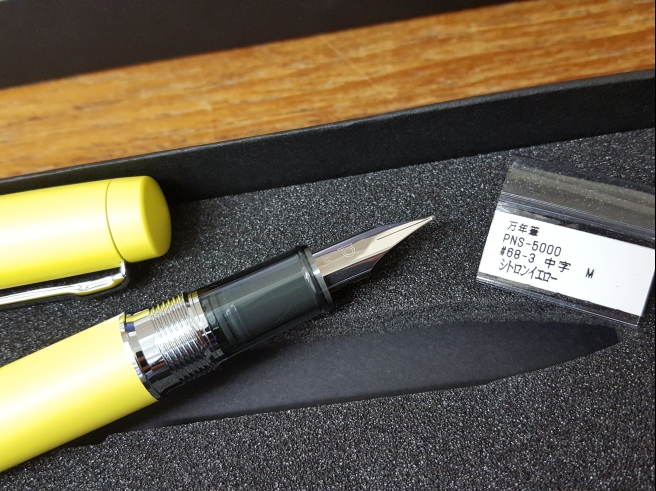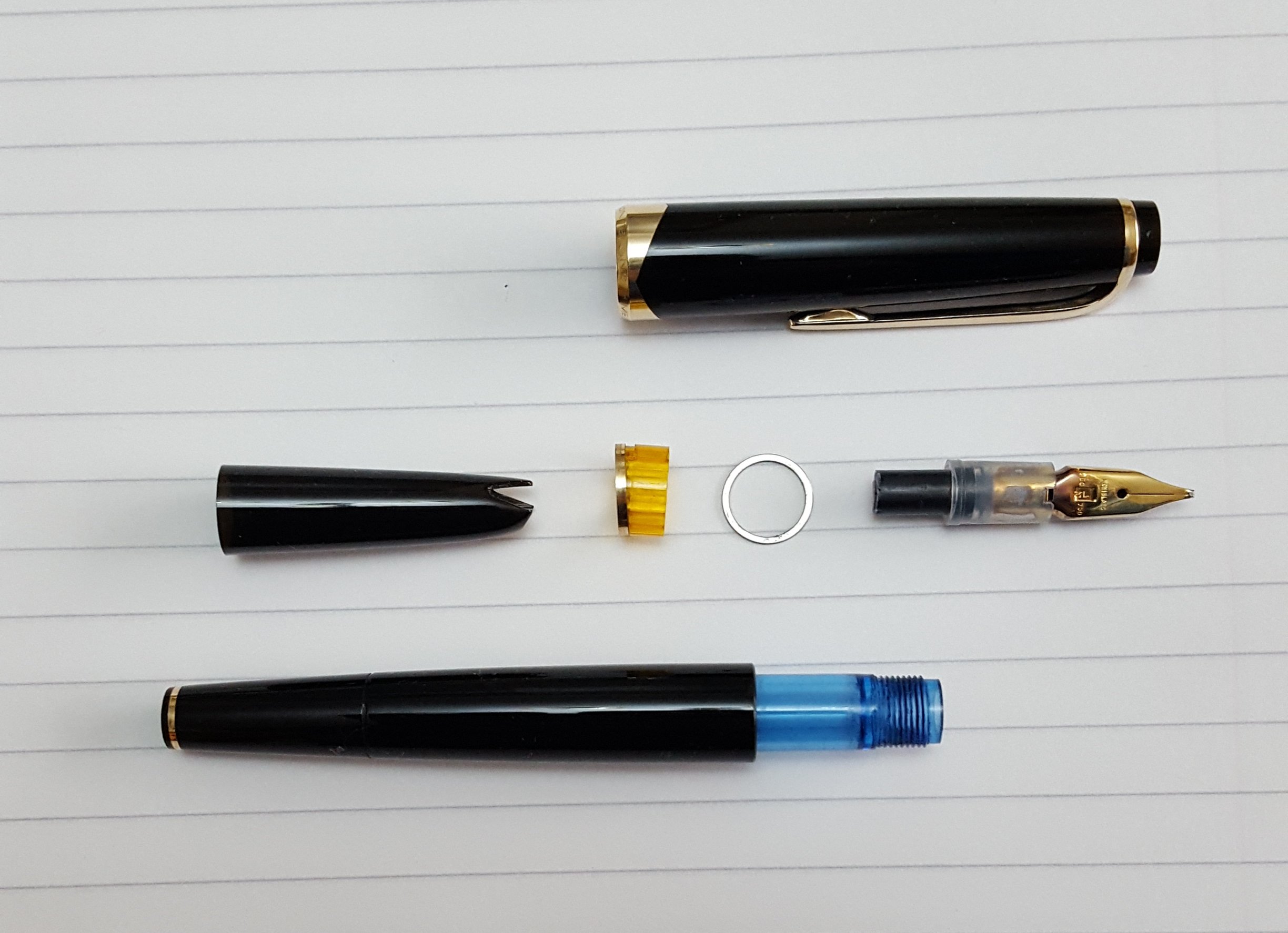I am pushing out this “first impressions” review with unseemly haste, as the pen has been with me for only half a day. However I saw that there had been some speculation and eager anticipation on Fountain Pen Network about this new model, although the thread Platinum Procyon New Model digresses into discussions of Platinum nibs generally and people’s differing experiences with the gold nib of the Platinum 3776.
I first learned of the Procyon while browsing on Cult Pens’ web site a few nights ago and was intrigued by the promotional video, showing the pen sucking up the last drops from an ink bottle, by means of the newly designed feed. And how nice to have a promotional video at all! The pen also benefits from Platinum’s slip and seal inner cap, which supposedly prevents ink drying out for up to 2 years. Also it boasts a steel nib offering flexible writing like a gold nib. With Cult Pens currently offering 10% off, and a free Platinum Preppy thrown in, it seemed worth a go.

Unboxing.
The pen arrived in a plain black cardboard box and separate lid, with a foam insert, and protected by a cardboard outer sleeve. The pen was in a polythene sheath. Also in the box were a sample set of three Platinum coloured ink cartridges, in Gold Ochre, Aqua Emerald and Dark Violet, plus one blue one and a fold out Instruction Manual. The box seems perfectly sensible and proportionate at this price point.

Construction and appearance.
The Procyon, or PNS 5000 as it is also called, is an aluminium pen, feeling solid but not overly heavy. The finish is matte, not glossy and feels pleasantly smooth and yet is not slippery. It has a screw cap (which is to be applauded) and despite the rather large area of screw threads on the section, the cap is removed in less than one full turn.
It is available in a choice of five colours. I chose Citron Yellow but the others are Deep Sea, Porcelain White, Turquoise Blue and Persimmon Orange.
The metal pocket clip is springy and moderately firm, and quite easy to use albeit not giving great security. There is a shiny cap ring, which is not sharp to the touch and the cap has the name PROCYON on the front, below the clip and PLATINUM, MADE IN JAPAN on the reverse.
The cap closes to be almost flush with the barrel, but is just slightly wider. This is achieved by having a small step down from barrel to section and to the shiny plated cap threads. The step and the threads are a bit sharp and uncomfortable and so you will probably want to find a grip which is either above or below the threads. Personally, I like to post the pen and hold it higher up so that my thumb is on the barrel. It is therefore important for me that the barrel material is not slippery (which this is not) in order to be able to anchor the pen with my thumb and keep the pen at the same angle.
The section is of a smokey grey translucent plastic, with a small lip at the nib end.
Unscrewing the barrel, with durable metal threads on both barrel and section, there is a generously long housing for the cartridge or else for a Platinum converter (not included but £4.99 from Cult Pens).
The cap can be posted, deeply and securely and being aluminium does not upset the balance.
Nib and Feed.
At first glance, the nib looks rather like those on the Lamy Safari and AL-Star. I chose a Medium. It does offer a little bit of flex but this is not very pronounced and it is not what I would describe as a flex nib. It does however have a pleasing softness or bounce, whereas Lamy steel nibs tend to be on the firm side. There is no breather hole on the nib, which features just the P for Platinum and M for medium.
The black plastic feed does not have any fins but does have a noticeable inlet, about half way up the nib. This is the breather hole which is also used to fill the pen from a bottle and so the nib needs only to be dipped in the ink sufficiently to cover the hole. This means less mess when filling and also that you can still fill the pen when the bottle has only a puddle of ink left, by tilting the bottle and positioning the feed in the ink, as in the promotional video.

I first tried the nib dipped in Pelikan Edelstein Smoky Quartz and was immediately impressed with its smoothness, good flow and some pleasant shading. For those who worried that the nib might be scratchy or dry I can say that my nib wrote smoothly and well, straight out of the box, with no skipping and was adequately wet. Of course I have only this one pen to go on and YMMV.
After trying the pen for a while on one dip of ink, I inserted one of the three coloured cartridges and went for the Gold Ochre, which is a nice autumnal dark orange.
Filling system.
This is a cartridge-converter pen, taking either Platinum’s proprietary cartridges or else the Platinum converter. It is slightly disappointing that a converter is not included at this price, particular as the ability to draw up the last dregs from a bottle is a feature of this pen. I do already have a converter from my Platinum Century 3776, which I might put to use once I have used up the cartridges. Another option is to recycle the old cartridges and syringe-fill them with ink of your choice.

Sizes and weights.
Closed, the pen is reasonably large and at 140mm is about the same length as a Lamy Studio and a bit wider. However, uncapped it is a bit on the short side at 118mm but posts well, to give a length of 155mm. It weighs 24g, which is quite a nice happy medium, neither too heavy nor too light.
Likes and dislikes.
It is exciting to try a completely new design, from a respected and long-established Japanese pen maker. With the proviso that my pen is only hours old, I venture the following:
Dislikes:
- The uncomfortable step and threads, which mean that you may want to adjust your grip to work around these;
- I am still coming to terms with the colour I chose, which is a sort of pastel lemon, giving the impression of an old and rather faded hi-viz jacket, but it is unusual and distinctive.
Likes:
- Smooth and effortless writing;
- Comfortable weight and balance;
- Screw cap;
- That feed! I am looking forward to experimenting with near empty ink bottles.
Conclusion.
It is early days but overall I am pleased with the pen, particularly how nicely it writes. Having a screw cap and a slightly softer nib plus the innovative feed feature lift it above the Lamy AL-Star, although it costs about twice as much as an AL-Star in the UK. It represents a step up from the entry level pens and a welcome change from the usual offerings of the big brands here. As to value, it is priced a little higher than a Cross Bailey or Parker Urban, which are metal and lacquer steel nib pens. For the writing experience that I have seen so far, (and my nib was perfect, out of the box) I think it is a good new option.








